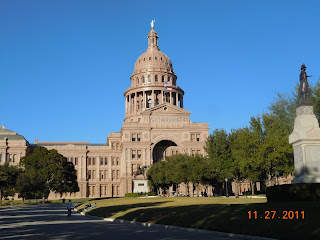 |
| State Capitol Building, Austin Texas |
During the Civil War, Texas was aligned with the Confederacy. Many battles were fought and the U.S. army posts that had been established during the 1850's were abandoned by the Union and taken over by the South. In fact, during the Civil War years Texas was sort of the gateway to the west for Confederate troops to infiltrate into the southern part of what was then New Mexico Territory. Many battles were fought there as well including the westernmost battle of the Civil War at Picacho Pass Arizona in April 1862. After the war's end, the western forts were occupied again by the U.S. Army. The southern pass through El Paso was reached by traveling through Texas and the state remained strategically important to traveling settlers. There's quite a bit of history of the "buffalo soldiers" who were garrisoned at many of the Texas forts after the Civil War trying to keep the trails safe from Comanche and Apache attacks.
The ranching business has always been important for Texas and in the latter part of the 1800'sit was huge. The two largest ranches during this time were the King Ranch just south of Corpus Christie and the XIT Ranch in the Texas Panhandle. The King Ranch was the oldest having begun prior to the American Civil War. It's interesting just how far apart geographically these two ranches were. The King Ranch was in the extreme southeast part of Texas and the XIT Ranch in the far northwestern corner.
The state of Texas was growing by leaps and bounds and it was apparent that a new Capitol would have to be built. That's why planning was already underway at the time of the 1879 fire at the old TX Capitol.
 |
| Capitol rotunda |
The Texas State Capitol building is just a few blocks south of the University of Texas campus and is comprised of twenty-two acres of grounds. The capitol building is mostly built from materials found in abundance in the nearby Texas Hill Country. The original plans were for the building to be constructed of limestone from a site just to the southwest of Austin. The limestone was found to have a high iron content and was discolored. The builders of the capitol then came across an offer from the owners of a Marble Falls Texas operation. Marble Falls is west of Austin in the Texas Hill Country. The owners of Granite Mountain offered to supply all the pink granite needed for the capitol building at no charge. Oak Hill limestone was used in the foundation and behind walls covered by the pink granite. Most of the buildings woodwork is oak and pine. The capitol building was constructed at a cost of $3.7 million. Labor consisted mostly of convicted prisoners and migrant workers.
 |
| Dome interior |
You may want to begin your tour of the capitol building at the Capitol Visitors Center located on the southeast corner of the capitol grounds. The address of the visitor's center is 112 East 11th Street. The Capitol Visitor Center exhibits many displays including a 15 minute video presentation concerning how the capitol was build from the sale of land to the XIT Ranch investors. Also included at the visitors center is a complete history of the Texas Governors Mansion. The capitol Visitor center is a great place for all information concerning Texas state history. History minded travelers will enjoy the visit.
Since Texas at one time was a republic, there is quite a lot of exhibits and information about the revolution that broke it free from Mexican rule. As an example, people helping Texas with their struggle against Mexico in 1836 received free land grants. Make sure to visit the largest display area on the second floor of the visitor center. There are six computers in a unique star-shaped kiosk that explores a time line of six distinct eras of Texas history. This includes both Texas Republic and Texas State history.
 |
| Volunteer Fireman Memorial, erected 1896. |
To learn more about Texas, it's time line in history from a Spanish and Mexican possession to an independent republic and then onto statehood, a side trip to the Texas State Capitol Building is a fun and educational visit. Austin Texas is about 200 miles southwest of Dallas and about 80 miles northeast of San Antonio.
(Photos from author's private collection).

